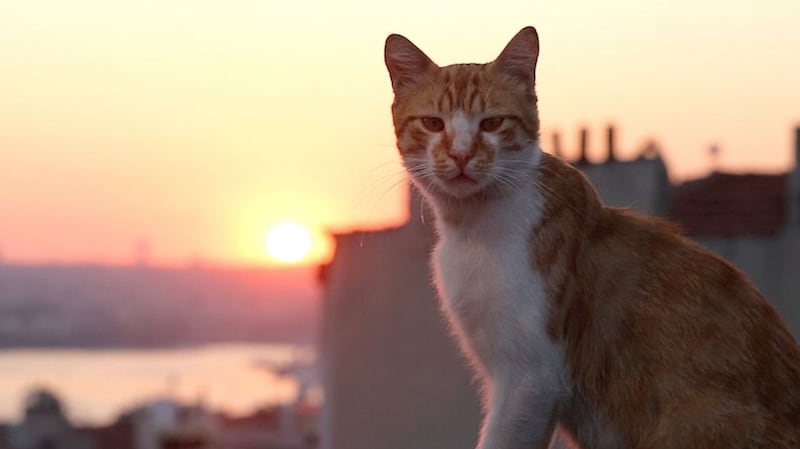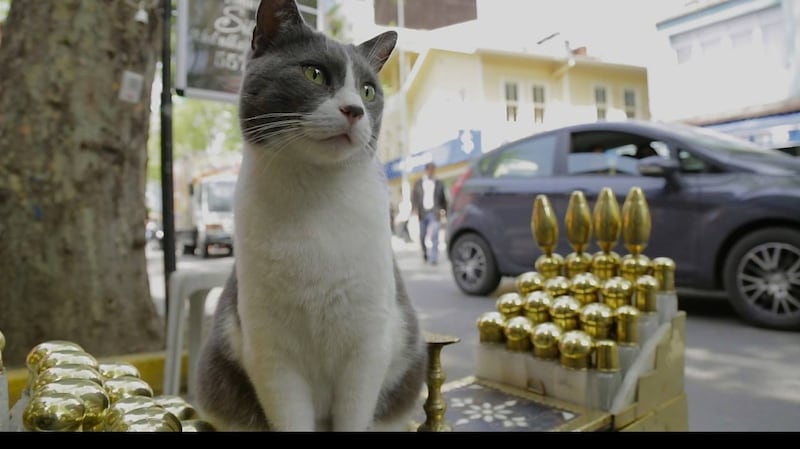For centuries, and through multiple name changes, street cats have roamed the city of Istanbul. They are wild and yet they do not behave like feral animals. Instead, they coexist peacefully alongside Istanbulites. Civic-minded locals place bowls of food and water on the pavement with signs that read “bon appetit”. Fishermen lay on freshly caught anchovies. Restaurateurs secure the services of the best micers with roast beef. Kittens receive freshly cooked chicken and enjoy custom-built shelters.
Empires, both Byzantine and Ottoman, have fallen. But the pussycat still strolls though markets and mosques.
These days, the city's kitty community is growing in popularity. The Cats of Istanbul Facebook page has more than 72,000 followers. When Barack Obama visited Turkey in 2009, he posed for a photo with one of the many strays living in the Hagia Sophia. Last October, the Kadiköy district erected a bronze statue of feline Instagram star Tombili. And now, the much-loved malkins have their very own movie. Kedi (which means "cat" in Turkish) is an extraordinary portrait of a city, its cats and the community that loves and cares for them.
To date, the film has grossed $2.7 million in the US, making it the third-highest-grossing foreign-language documentary of all time. It has been snapped up by video-on-demand service YouTube Red.
Special relationship
It's a special film about a special relationship. "I should say this is the case in a lot of places in Turkey; it's not unique to Istanbul," says Ceyda Torun, Kedi's director. "One major factor is that cats are native to this part of the world. They originate in Northern Africa and the Fertile Crescent, where humans started farming. And then arrived with the fishing community thousands of years ago. When I was researching the film, I interviewed a zoologist who showed us a cat skeleton from 3,500 years ago that had been found on the shores of the Bosphorus. He had a break in a thigh bone that could only have healed in the way that it did if it was wrapped up by a human."

Islam has almost certainly strengthened human-feline relations in Istanbul. The only animal permitted to enter the Great Mosque of Mecca is revered by the religion. According to various hadiths, the prophet Muhammad allowed a cat to give birth on his cloak, and cut off the sleeve of his prayer robe rather than disturb his pet cat, a female named Muezza, as she slept.
The prophet was saved from a deadly snake by the pet cat of his companion, Abu Hurayrah. In return, Muhammad blessed cats with the ability to always land on their feet.
If you kill a cat and wish to avoid hell, you have to build five mosques
“There are many stories of how Muhammad interacted with cats,” says the filmmaker, who was raised in Istanbul, but who now lives in the US. “If you kill a cat and wish to avoid hell, you have to build five mosques.”
She laughs: “But I suspect some people use that to rationalise their devotion to cats.”
Human participants
Kedi doesn't name its human participants, even when they are well-known Turkish figures. (The cartoonist Bulent Ustun, creator of Serafettin, a street-wise cartoon tomcat, pops up, without fanfare, to discuss the cats who historically disembarked fishing vessels during the Ottoman era.)
Kedi instead keeps pace with such wonderful four-legged characters as Psikopat (which means exactly what you might think), a jealous "wife" who guards her mate from other curious females, but who will shove him away from the kibble pile when she's hungry. Or Duman, the gentlemanly gourmand who was on a smoked meat and Emmenthal weight-loss plan at his favourite restaurant, yet can occasionally be found sampling from a dumpster. Or the happy-go-lucky Gamsiz, whose "main human" explains he has a running tab with local vets. "We all do."
We couldn't shoot it like a nature documentary, with hidden cameras in places that the cats frequent often. In a city, that wouldn't work
These furry stars are followed in fluid, cat’s-eye level tracking shots. “We tried a remote control mounted camera, but the cats completely hated it. They either ran away from it or fought it. We looked at special vests but cats don’t like those. No matter how comfortable, they hate anything that throws off their balance and they just sit down in protest. And we couldn’t shoot it like a nature documentary, with hidden cameras in places that the cats frequent often. In a city, that wouldn’t work.
‘Ankle height’
“After spending two days hunched over with a camera at ankle height, we realised that we had a physical issue that was going to potentially become a medical issue. So we ended up with a light L-shaped rig attached at the ankle.”
There were further issues with the talent. Before the shoot, local producers and researchers walked around the streets asking people about their neighbourhood cats. They found 35 subjects: just over half turned up.
Throughout the shoot, there were seven of us in a van and we would get phone calls from the human participants
“We were only able to film 19 of them over two-and-half-months. The majority just didn’t show up or they showed up once and didn’t come back. Out of those 19, we only ended up with seven full stories that were really unique. Throughout the shoot, there were seven of us in a van and we would get phone calls from the human participants. We had a lot of help from people to get to the right place at the right time.”
Kedi is characterised by incredible acts of kindness: an old man racing to a vet with an injured newborn kitten; the baker who keeps a tip jar to care for the cats outside his premises; the woman who says that cooking and dispensing chicken to street cats on a daily basis has allowed her to heal.

“I mainly tried to focus on people who try to uphold the more traditional way of coexisting with cats: namely that you give them food that’s leftover and try to take care as best you can,” says Torun. “There is also a community that approach the cats in a more western way – trapping, neutering, spaying – it’s hard to say which is the right way.”
Abandoned
Last spring, Feral Cats Ireland estimated that Ireland’s stray and wild feline population – many of whom have been abandoned by domestic owners – runs into hundreds of thousands. One female cat and her offspring can be responsible for a colony of 30 cats – and maybe more – in just one year.
There is a problem about cruelty to animals among young people, specifically, that is very difficult to understand
Might these animals benefit from the Istanbul approach, that is, civic-minded individuals feeding scraps and kibble to strays?
Cyrileen Power of Cats Aid is sceptical that Ireland, as a nation, could similarly embrace our feline population. “The attitude towards animals generally and cats in particular is not great,” she says. “There is a problem about cruelty to animals among young people, specifically, that is very difficult to understand.”
Earlier this year, various charities called for animal welfare to be taught in schools. Cats Aid claims that cats are used to blood greyhounds and that our new property boom has created more and more displaced litters.
“Cats in this country are treated like vermin,” says Power. “It’s just part of our psychology. There tends to be a lot more focus on rescuing horses and dogs. The trap-neuter-return programme is so important. But there’s not enough political support. There are no votes in cats.”
‘Tumultuous relationship’
Torun is more optimistic. “Europe has a more tumultuous relationship with the cat, which has associations with witchcraft, and femininity and mysteriousness. Certain cultures are more dismissive of those things. But in LA, for example, there’s a programme to place feral cats in rodent-infested warehouses, and flower markets, and police stations. And the rodents soon move on. There is a middle ground. And that middle ground is the origins of our relationship with cats.
“Years ago, cats and dogs ate the food we didn’t eat – we didn’t need to send it all to a landfill. So this touches on a wider conversation we need to have about living more harmoniously with nature.”
Kedi opens on June 30th












